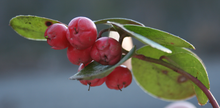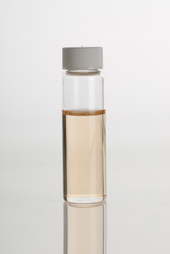Wintergreen
This article needs additional citations for verification. (August 2014) |

Wintergreen is a group of aromatic plants. The term "wintergreen" once commonly referred to plants that remain green (continue photosynthesis) throughout the winter. The term "evergreen" is now more commonly used for this characteristic.
Most species of the shrub genus Gaultheria demonstrate this characteristic and are called wintergreens in North America, the most common generally being the American wintergreen (Gaultheria procumbens). Wintergreens in the genus Gaultheria contain an aromatic compound, methyl salicylate, and are used as a mintlike flavoring.
Uses

Wintergreen berries, from Gaultheria procumbens, are used medicinally. Native Americans brewed a tea from the leaves to alleviate rheumatic symptoms, headache, fever, sore throat, and various aches and pains. These therapeutic effects likely arose because the primary metabolite of methyl salicylate is salicylic acid, a proven NSAID that is also the metabolite of acetylsalicylic acid, commonly known as aspirin. During the American Revolution, wintergreen leaves were used as a substitute for tea, which was scarce.[1]
Wintergreen is a common flavoring in American products ranging from chewing gum, mints, and candies to smokeless tobacco such as dipping tobacco (American "dip" snuff) and snus. It is a common flavoring for dental hygiene products such as mouthwash and toothpaste. It is a component of the American-origin drink root beer.
Wintergreen oil can also be used in fine art printing applications to transfer a color photocopy image or color laser print to a high-rag-content art paper, such as a hot-press watercolor paper. The transfer method involves coating the source image with the wintergreen oil then placing it face-down on the target paper and pressing the pieces of paper together under pressure using a standard etching press.
Wintergreen oil is an ingredient in some popular vegetable-oil based lubricants used in firearm maintenance. These products, sold under the names Seal1 and Frog Lube, are proprietary blends of vegetable oils intended to clean, lubricate and preserve the metal surfaces of firearms.[2] They have the advantages over petroleum-based products of being non-toxic and biodegradable.
Artificial wintergreen oil, which is pure methyl salicylate, is used in microscopy because of its high refractive index.[3]
Oil

The Gaultheria species share the common characteristic of producing oil of wintergreen. Wintergreen oil is a pale yellow or pinkish fluid liquid that is strongly aromatic with a sweet, woody odor (components: methyl salicylate (about 98%), α-pinene, myrcene, delta-3-carene, limonene, 3,7-guaiadiene, and delta-cadinene)[4] that gives such plants a distinctive "medicinal" smell whenever bruised. Salicylate sensitivity is a common adverse reaction to the methyl salicylate in oil of wintergreen; it can produce allergy-like symptoms or asthma.
Wintergreen essential oil is usually obtained by steam distillation of the leaves of the plant following maceration in warm water. Methyl salicylate is not present in the plant until formed by enzymatic action from a glycoside within the leaves as they are macerated in warm water.[5] Oil of wintergreen is also manufactured from some species of birch, but these deciduous trees are not called wintergreens. Spiraea plants also contain methyl salicylate in large amounts and are used similarly to wintergreen. Wintergreen has a strong "minty" odor and flavor; however, the Gaultheria-genus plants are not true mints, which belong to the genus Mentha.
Wintergreen oil is used topically (diluted) or aromatherapeutically as a folk remedy for muscle and joint discomfort, arthritis, cellulite, obesity, edema, poor circulation, headache, heart disease, hypertension, rheumatism, tendinitis, cramps, inflammation, eczema, hair care, psoriasis, gout, ulcers, and broken or bruised bones.[citation needed] The liquid salicylate dissolves into tissue and also into capillaries and hence some will enter into the blood stream where it could present similar risks to some aspects of Aspirin for certain people, such as those with thrombosis. Wintergreen also is used in some perfumery applications and as a flavoring agent for toothpaste, chewing gum, soft drinks,[4] confectionery, Listerine, and mint flavorings. One application is rust removal and degreasing of machinery. Wintergreen is particularly effective for breaking through sea water corrosion.[citation needed]
Wintergreen oil has been shown to be beneficial in the restoration of the flexibility to hardened rubber components. [6]
Toxicity of oil
One milliliter (20 drops) of oil of wintergreen is equivalent to about 1860 mg of aspirin, or almost six regular-strength adult aspirin tablets.[7]
Treatment is identical to the other salicylates. Early use of hemodialysis in conjunction with maximal supportive measures is encouraged in any significant ingestion of methyl salicylate.[8]
See also
- Gaultheria humifusa—alpine wintergreen
- Gaultheria ovatifolia—western teaberry or Oregon spicy wintergreen
- Chimaphila maculata—striped wintergreen
References
- ^ Balch, Phyllis A. (2002-01-01). Prescription for Herbal Healing. Penguin. ISBN 9780895298690.
- ^ "Froglube, Tracklube, and Seal1 Laboratory Analysis". Vuurwapen Blog. 2016-01-14. Retrieved 2018-09-20.
- ^ Cecilia W. Lo, 2000. Developmental biology protocols, Volume 1, Springer in google books
- ^ a b "Analysis of Wintergreen Oil | Chemistry | Nature". Scribd. Retrieved 2018-09-20.
- ^ Essential Oil Profile of Wintergreen by Ingrid Krein
- ^ https://www.youtube.com/watch?v=EnGsllKvheQ
- ^ Johnson PN: Methyl salicylate/aspirin equivalence: Vet Hum Toxicol 1985; 26:317-318
- ^ Howrie DL, Moriaty R, Breit R: Candy flavoring as a source of salicylate poisoning. Pediatrics 1985; 75:869-871
- Beck TR, Beck JB (1963). Elements of Medical Jurisprudence, ed 11. Philadelphia, JB Lippincott, 1963.
- Stevenson CA (1937). "Oil of wintergreen poisoning". Med Sci 193:772–788.
- McGuigan MA (1987). "A two-year review of salicylate deaths in Ontario". Arch Intern Med 147:510–512.
